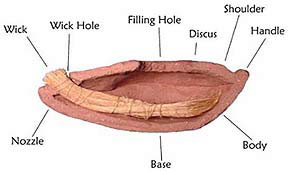Write your own label for the plant pathogens
Sticks like these harvest wild rice
Pharyngeal teeth from a Freshwater drum (Aplodinotus grunniens)
Luring lunkers through the winter ice
Big discoveries come in small packages
Paddlefish (Polyodon spathula) skull
Pre-Columbian ceramic from Costa Rica
Oil lamps were one of the most common household items of ancient times. Lamps made of stone or shell were used as early as the Stone Age. Ceramic lamps like this one were used all over the Mediterranean area from 2000 B.C. through the Middle Ages. They were used to burn oil, usually a plant oil such as olive oil that was abundant. Archaeologists find fewer lamps in areas like Britain, because oil was scarce and expensive there.
Lamps could be decorated with almost any scene, from divinities to animals to abstract decoration. This particular lamp depicts Eros (Cupid), the son of Aphrodite and the agent of love, carrying a basket of fruit in one hand and a small goat in the other. Eros was a commonly used subject in Greek and Roman art and is most often represented as a winged baby.
Necklace of Rosary Pea and Jobs Tears beads
The strange skull of a common catfish
Emily the two-headed snapping turtle
An ancient bone marks a new type of dinosaur

Be a part of the Buzz!Registerorlog in

Helpful hints to be a better label writer.

Plaster jackets of hadrosaur limb bones
On the lamps base is what is called a makers mark, which was a symbol or name indicating the specific workshop that created the lamp. This can be useful for archaeologists, because it can sometimes tell us where and when the lamp was made. This particular potters mark, three crossed palm branches bound together, is found on lamps made in Egypt in the 2nd and 3rd centuries AD.
Science Buzz is supported by theNational Science Foundation.
Qayaq or kayak? Whatever floats your boat
Don, a male Western Lowland Gorilla
Aside from their basic functional use for indoor and outdoor illumination, lamps also served other purposes. They were buried in tombs and graves along with pottery, jewelry, and other symbolic gifts. They could also be dedicated as votive offerings to gods and goddesses in temples and sanctuaries.
This tiny bottle represents a vast empire
The lamp used a wick, made from fibers such as linen or papyrus, that was inserted into the body of the lamp. The end of the wick rested in the nozzle. The oil was poured into the lamp though the filling hole on top of its body. The wick was lit and a small flame was emitted from the tip of the wick resting in the nozzle. The lamp could be set on any flat surface but was also portable and could be carried in a persons hand.
Rapetosaurus krausei dorsal vertebra
Carcharodon angustidens tooth; Carcharodon megalodon tooth
Snow goggles helped Arctic people survive
Fossil Camel Skull (Poebrotherium sp.)
Nothing is old hat with Maya fashion
A diatom, Stephanodiscus niagarae, Ehrenberg
Lamps were made using a two-part mold. Wet clay was pressed into each half of the mold and then the two halves were joined together. They were allowed to dry slightly, and then the molds were removed and the oil-hole and wick-hole were pierced by hand. Finally, the lamp was fired in a kiln for up to two days.
»Features»Object of the Month»Archive
Silver tetradrachm coin of Alexander the Great